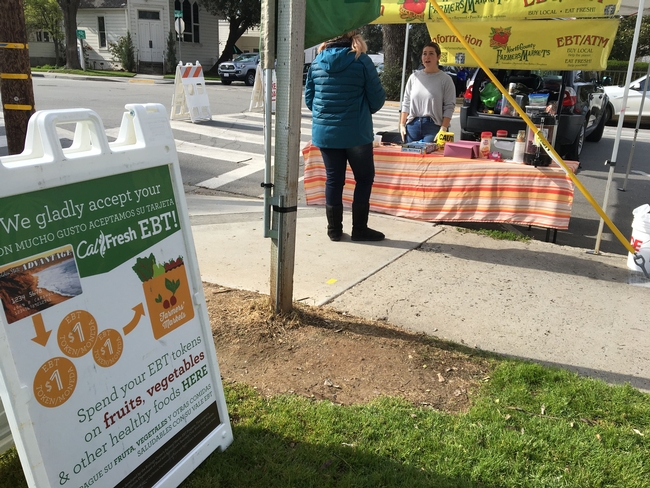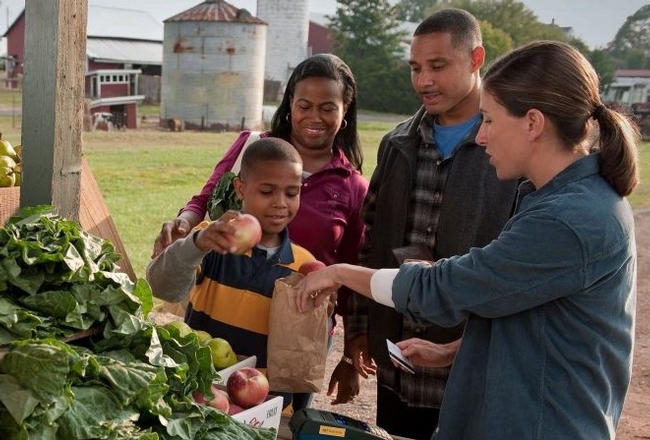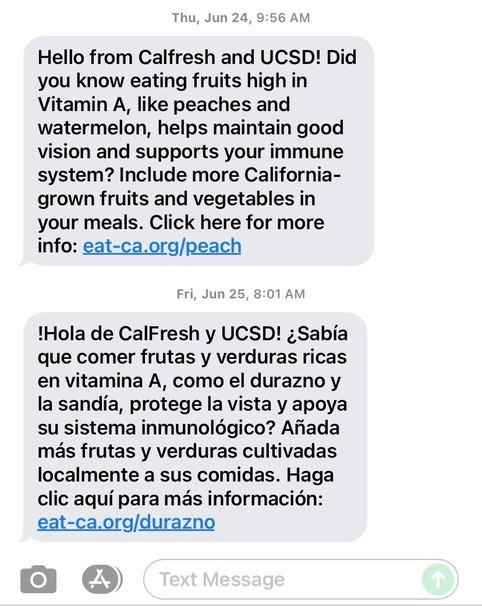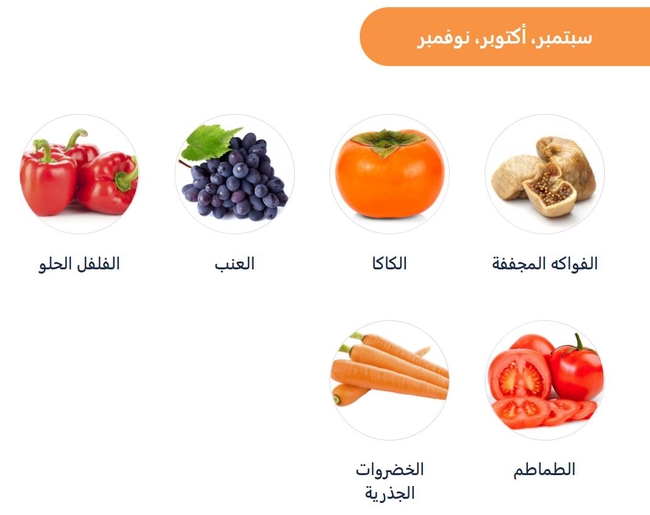Posts Tagged: Wendi Gosliner
UC ANR experts offer counsel as CalFresh benefits shrink, participants face hunger
Reduction of SNAP benefit deepens crisis of inflation, high cost of living, low wages
Starting this month, many of the estimated 3 million people in the CalFresh program – California's version of SNAP (Supplemental Nutrition Assistance Program) – will be facing hunger and making difficult decisions to meet their most basic needs. In late March, participants received the last of the pandemic-related emergency aid that significantly boosted their monthly benefits. The reduction varies by household size and income; for example, in April a single-person household could see a drop from $281 per month to $23.
“The emergency food allotments had a tremendous impact in our communities and across the nation,” said Shannon Klisch, academic coordinator for the Youth, Families and Communities Program for UC Cooperative Extension in San Luis Obispo and Santa Barbara counties. “One study estimated that these allotments kept more than 4 million people out of poverty across the U.S. in the last quarter of 2021, and reduced child poverty by 14%.”
SNAP increases during the pandemic made many Californians more food-secure, with some participants reporting that their allotments finally had been enough to feed their families for the month, according to Wendi Gosliner, a project scientist at the Nutrition Policy Institute (a program of UC Agriculture and Natural Resources). But, with the benefit reductions, food insecurity is emerging again as a serious concern.
“It is inconceivable that a nation this wealthy should have so many people experiencing hunger,” Gosliner said. “And here in California, with the high cost of living, ongoing inflation and extreme income and wealth disparities, people are being forced to explore every possible avenue just to feed themselves and their families.”
To help ensure they are receiving the maximum allotment, Klisch recommends that CalFresh participants – especially those who applied during the pandemic and are relatively new to the program – double-check their information.
“If the county doesn't have your most up-to-date information, call your county worker if you've changed your address, if you've experienced decreased income, if your housing costs have gone up, or if you have new expenses – like child or dependent care expenses or medical expenses – these can help you qualify for more CalFresh funds,” she explained.
For families with school-aged children, Klisch said they can stretch their food dollars and promote healthy eating by encouraging their children to eat breakfast and lunch at school through California's universal free school meals, and all families with children under 18 can watch for the next issuance of the P-EBT (Pandemic EBT) card, worth potentially hundreds of dollars.
In addition to these options for food assistance, Klisch pointed to programs that can help people save money on other household expenses, such as California Alternate Rates for Energy Programs (CARE) and Affordable Connectivity Program. Local food banks are also gearing up across the state to handle an expected surge in clients in need of emergency food; a list of California food banks can be found at cafoodbanks.org/our-members.
“We ask a lot of low-income families and workers to navigate and piece together various programs, applications, and benefits when we don't commit to a strong safety net,” Klisch said. “On the other hand, when people have enough money for food, everyone benefits through decreased health care costs and increased economic activity.”
Gosliner also said that people should look into their eligibility for WIC (Special Supplemental Nutrition Program for Women, Infants and Children), as well as the federal Earned Income Tax Credit (EITC) and CalEITC, poverty-alleviation benefits underused by Californians.
“People should make sure they are accessing all the safety net benefits for which they are eligible,” Gosliner said.
Market Match, other nutrition incentive programs can help
Through programs like Market Match, available at about 300 farmers markets across California affiliated with the Ecology Center, CalFresh participants can have their EBT benefits “matched” by their local market (usually up to $10 or $15 per visit).
“People are looking to get creative about how to stretch their food dollars, and Market Match is one way to do that,” said Klisch, who has led UCCE efforts to help promote the program along the Central Coast since 2017.
Striving to expand access to fresh fruit and vegetables and to support local farms, UCCE and CalFresh Healthy Living, UC worked with partners to increase CalFresh redemption at farmers markets in San Luis Obispo and northern Santa Barbara counties.
In 2017, about $48,000 in CalFresh and Market Match benefits were redeemed at farmers markets in the area. In 2022, the total was more than $207,000 – a 327% increase. According to Ecology Center figures for the entire state, CalFresh and Market Match spending at farmers markets jumped 161% from 2019 to 2021, up to $13 million.
Gosliner, whose research has shown that these nutrition incentive programs are associated with increased food security, noted that “the people who use Market Match absolutely love the program and feel it is incredibly helpful.” She also added that the California Department of Social Services is developing a pilot program that would offer match incentives for purchasing fruits and vegetables at larger food retailers.
Although the biggest of its kind, Market Match is just one of the programs across California that provide “matches” for healthy food purchases under the California Nutrition Incentive Program, which in turn is primarily funded by GusNIP (the nationwide Gus Schumacher Nutrition Incentive Program).
GusNIP dollars – and SNAP overall – are governed by the federal Farm Bill, typically renewed every five years and currently being negotiated by Congress.
Study probes why 1 in 4 eligible Californians do not receive poverty-alleviation benefit
UC researchers identify barriers to Earned Income Tax Credit, which provides up to $7K each year per family
About 1 out of 4 Californians who are eligible for the Earned Income Tax Credit do not actually receive it – and University of California researchers are digging deeper to learn why they are not taking up this crucial benefit, which can provide nearly $7,000 annually for each family.
“The EITC is the largest poverty alleviation program in the country for families with kids, lifting millions of people out of poverty every year,” said Rita Hamad, associate professor at the University of California, San Francisco in the Institute for Health Policy Studies. “We know from previous work – including our own studies – that the EITC is effective at improving health, including birth weight, child development, household food security, and parents' mental health.”
Hamad is the co-lead author of an article on EITC take-up, recently published in Health Affairs, which begins to answer why only 74% of Californians receive the EITC benefit for which they are eligible.
“Billions of dollars are going unclaimed by families who could really use the money to improve their families' health and well-being,” said Hamad, who is also director of UCSF's Social Policies for Health Equity Research Program.
More broadly, about 80% of eligible families across the country take advantage of the EITC, according to previous research. But those studies only looked at tax records, and do not shed light on the specific circumstances of households that missed the credit.
“What our study did was reach out to those families and start to collect some richer information on what's happening – why aren't people getting the benefit, and what can we learn to help more people get something that can make a big difference for families,” said co-lead author Wendi Gosliner, project scientist at the Nutrition Policy Institute, a program of UC Agriculture and Natural Resources.
On EITC, ‘the more we know, the better'
Surveying 411 EITC-eligible Californians with children, researchers found that roughly 25% of respondents did not receive the benefit (including the 9% that did not file taxes). And although the sample is non-representative, the study did produce some significant findings.
For example, take-up of the EITC and CalEITC (its California state counterpart) was less likely among eligible individuals who do not speak English, had no prior knowledge of the programs, and are younger.
The age factor – correlated with inexperience in tax filing – underscores the need to clarify eligibility verbiage and materials. Gosliner noted that several respondents thought all people under the age of 25 were ineligible, when in fact those under 25 who have dependents would qualify for the federal credit (for the CalEITC, all individuals over 18 are eligible).
Such findings help fine-tune the education and outreach activities of advocacy groups such as Golden State Opportunity, a nonprofit that works to create financial stability for low-income workers across California.
“Knowing that a barrier for younger people is lack of knowledge, we can increase our outreach to community colleges and other youth-serving organizations with messaging that reaches them where they are,” said Amy Everitt, president of Golden State Opportunity. “Thanks to this research we can better understand the diverse audiences we need to reach – when it comes to the EITC, the more we know, the better.”
Need for clearer tax information, better processes
The researchers are currently analyzing the qualitative data they gathered from the interviews to produce a follow-up paper. But Gosliner shared that some of the respondents' concerns were worries about owing the government, the belief that filers must pay back the EITC money, and lack of understanding about the tax system in general and the EITC specifically.
“It's very user-unfriendly,” Gosliner said. “Even the name of the program doesn't make sense to people – they don't understand it, they don't know what it means...it's like we intentionally create these hurdles to receive the benefit.”
Both Gosliner and Hamad recommended that the government simplify the tax process, while providing free, high-quality filing services in multiple languages to ensure families are receiving the benefits that can help reduce health inequities.
“Our study speaks to the fragmentation of the social safety net, with families needing to fill out multiple redundant applications to participate in each different program,” Hamad said. “A better solution would be to have government agencies coordinate with one another, so that families who are cash-strapped with limited time can fill out just one streamlined application.”
Information on federal EITC: https://www.irs.gov/credits-deductions/individuals/earned-income-tax-credit-eitc
Information on CalEITC: https://www.caleitc4me.org/
The full article can be found at: https://www.healthaffairs.org/doi/10.1377/hlthaff.2022.00713
The other authors of the study are: Erika M. Brown, UCSF; Mekhala Hoskote, UC Berkeley and UCSF; Kaitlyn Jackson, UCSF; Elsa M. Esparza, UC Berkeley; and Lia C. H. Fernald, UC Berkeley.
Study: Government shutdown stressed food assistance program participants
A U.S. federal government shutdown can represent a minor inconvenience, a delay in paychecks, or – for people living in some of the most difficult circumstances – an extended period of hunger and anxiety.
A study published recently in the journal Nutrients provides a unique glimpse into the shutdown experiences of participants in CalFresh – California's name for the federally funded Supplemental Nutrition Assistance Program (formerly known as food stamps). Currently, about 42 million people participate in SNAP across the U.S.
In focus groups conducted in 2019 with 26 low-income CalFresh participants from four diverse California counties, participants shared how the 2018-19 federal government shutdown affected their SNAP benefits, their perception of the program and their faith in government.
One of the immediate effects of the 2018-19 shutdown was that February CalFresh benefits were distributed in January. And while that meant program participants saw extra benefits that month, they then had to wait 40 to 44 days until the March issuance – much longer than the usual 28 to 31 day cycle.
“What we saw with this study is that this extended lag in benefit receipt from January to March was devastating,” said Wendi Gosliner, senior researcher and policy advisor at the Nutrition Policy Institute of UC Agriculture and Natural Resources, and an author of the study funded by UC ANR.
She recalled one participant who, despite having a gastrointestinal issue that requires a special diet, had to eat canned food from the food bank that made her sick – rather than go hungry while waiting for her March benefits. Others described cascading financial challenges after using rent money for food in February, or going into debt to pay for food and getting behind on other expenses.
The study also chronicles the experiences of a woman who was anguished to hear the suffering of her daughter, also a CalFresh participant: “She called me several times crying, ‘Ma, I don't – we don't have enough food. What am I going to do…? You know, I can't afford to this and this and this.' And I can't help her.”
For individuals grappling with food insecurity, the stress of feeding their families was compounded by the uncertainties of the government shutdown. And while many participants exercised their agency and resourcefulness in coping with the situation, they also felt a degree of powerlessness amid the “confusion and craziness,” as one person put it.
“No one knew how long that shutdown was going to last; no one knew if the March benefits were going to be paid,” Gosliner said. “And as we learned, there were all kinds of stories circulating out there about what was going on with the uncertainty – a lot of people didn't have the information about what was actually happening.”
Some participants, seeing the “double benefit” in January 2019, thought that it was the last-ever distribution and that SNAP was ending. Others described being unable to get in touch with the CalFresh agency to get their questions answered about the benefits. Most participants had not heard about the disrupted benefit schedule before receiving the benefits. As a result, many people in the focus groups shared that their overall faith in government had been shaken.
Improving customer service, boosting benefit levels and adjusting eligibility and benefit formulas to reflect high cost-of-living and expenses related to working were three recommendations that came from the focus group participants.
A fourth recommendation tackles the shutdown issue head-on: Don't let it happen again.
“Congress should do absolutely everything in their power to be sure that the program operates on the usual time schedule – even if the government is shut down,” Gosliner said.
In the context of the global pandemic, when financial and social inequities and physical and mental health disparities have been laid bare, ensuring access to healthful food is even more important. And with studies showing that hospitalizations increase with longer lags between SNAP distributions, Gosliner said the “absolute last thing” the overburdened health system needs is more people in emergency departments seeking acute care.
“It's the worst time to be having people who need money to feed their families face additional insecurity,” she said. “It's critically important that Congress acts to be sure that there is not any disruption in benefits.”
The authors of the study, “Participants' Experiences of the 2018–2019 Government Shutdown and Subsequent Supplemental Nutrition Assistance Program (SNAP) Benefit Disruption Can Inform Future Policy,” are Wendi Gosliner, Wei-Ting Chen, Cathryn Johnson, Elsa Michelle Esparza, Natalie Price, Ken Hecht and Lorrene Ritchie.
The study can be found online at https://www.ncbi.nlm.nih.gov/pmc/articles/PMC7353319.
Study: Government shutdown stressed food assistance program participants
A U.S. federal government shutdown can represent a minor inconvenience, a delay in paychecks, or – for people living in some of the most difficult circumstances – an extended period of hunger and anxiety.
A study published recently in the journal Nutrients provides a unique glimpse into the shutdown experiences of participants in CalFresh – California's name for the federally funded Supplemental Nutrition Assistance Program (formerly known as food stamps). Currently, about 42 million people participate in SNAP across the U.S.
In focus groups conducted in 2019 with 26 low-income CalFresh participants from four diverse California counties, participants shared how the 2018-19 federal government shutdown affected their SNAP benefits, their perception of the program and their faith in government.
One of the immediate effects of the 2018-19 shutdown was that February CalFresh benefits were distributed in January. And while that meant program participants saw extra benefits that month, they then had to wait 40 to 44 days until the March issuance – much longer than the usual 28 to 31 day cycle.
“What we saw with this study is that this extended lag in benefit receipt from January to March was devastating,” said Wendi Gosliner, senior researcher and policy advisor at the Nutrition Policy Institute of UC Agriculture and Natural Resources, and an author of the study funded by UC ANR.
She recalled one participant who, despite having a gastrointestinal issue that requires a special diet, had to eat canned food from the food bank that made her sick – rather than go hungry while waiting for her March benefits. Others described cascading financial challenges after using rent money for food in February, or going into debt to pay for food and getting behind on other expenses.
The study also chronicles the experiences of a woman who was anguished to hear the suffering of her daughter, also a CalFresh participant: “She called me several times crying, ‘Ma, I don't – we don't have enough food. What am I going to do…? You know, I can't afford to this and this and this.' And I can't help her.”
For individuals grappling with food insecurity, the stress of feeding their families was compounded by the uncertainties of the government shutdown. And while many participants exercised their agency and resourcefulness in coping with the situation, they also felt a degree of powerlessness amid the “confusion and craziness,” as one person put it.
“No one knew how long that shutdown was going to last; no one knew if the March benefits were going to be paid,” Gosliner said. “And as we learned, there were all kinds of stories circulating out there about what was going on with the uncertainty – a lot of people didn't have the information about what was actually happening.”
Some participants, seeing the “double benefit” in January 2019, thought that it was the last-ever distribution and that SNAP was ending. Others described being unable to get in touch with the CalFresh agency to get their questions answered about the benefits. Most participants had not heard about the disrupted benefit schedule before receiving the benefits. As a result, many people in the focus groups shared that their overall faith in government had been shaken.
Improving customer service, boosting benefit levels and adjusting eligibility and benefit formulas to reflect high cost-of-living and expenses related to working were three recommendations that came from the focus group participants.
A fourth recommendation tackles the shutdown issue head-on: Don't let it happen again.
“Congress should do absolutely everything in their power to be sure that the program operates on the usual time schedule – even if the government is shut down,” Gosliner said.
In the context of the global pandemic, when financial and social inequities and physical and mental health disparities have been laid bare, ensuring access to healthful food is even more important. And with studies showing that hospitalizations increase with longer lags between SNAP distributions, Gosliner said the “absolute last thing” the overburdened health system needs is more people in emergency departments seeking acute care.
“It's the worst time to be having people who need money to feed their families face additional insecurity,” she said. “It's critically important that Congress acts to be sure that there is not any disruption in benefits.”
The authors of the study, “Participants' Experiences of the 2018–2019 Government Shutdown and Subsequent Supplemental Nutrition Assistance Program (SNAP) Benefit Disruption Can Inform Future Policy,” are Wendi Gosliner, Wei-Ting Chen, Cathryn Johnson, Elsa Michelle Esparza, Natalie Price, Ken Hecht and Lorrene Ritchie.
The study can be found online at https://www.ncbi.nlm.nih.gov/pmc/articles/PMC7353319.
CalFresh participants welcome texts on benefits of California-grown produce
The buzz or chirp of an incoming text message started some San Diego County residents on the path to a healthier diet during this past year. In September 2020, most CalFresh participants in the county – more than 172,000 households – began receiving monthly text messages about the benefits of California-grown fruits and vegetables as part of a pilot program.
This novel approach to delivering nutrition messages to California food assistance program participants was developed by a partnership of the Nutrition Policy Institute of UC Agriculture and Natural Resources, the UC San Diego Center for Community Health and the County of San Diego Health and Human Services Agency, which administers CalFresh in the county.
The HHSA, which had been using its text messaging platform to send administrative reminders and alerts, was receptive to using the tool for sending nutrition-focused information. NPI and CCH partnered with ideas42, a firm that applies behavioral science to solutions for social change, to develop a series of five text messages promoting California-grown fruits and vegetables.
The text messages – originally delivered in English and Spanish, with the addition of Arabic beginning in July 2021 – were friendly and conversational in tone.
“In a text, you have very few characters you're communicating with people, so we wanted to make sure we were using cutting-edge behavioral science to construct those messages to have the most impact,” said Wendi Gosliner, NPI senior researcher and policy advisor.
Each text included a link directing recipients to a website developed as part of the project, with information on selecting, storing and preparing California-grown fruits and vegetables; health benefits; tips to reduce food waste; and recipes – including TikTok videos.
Initially running from September 2020 to March 2021, the pilot program was well-received. Nearly 90% of CalFresh participants responding to a survey said they appreciated receiving the texts. “It is very important for us to eat healthy, to teach our children to eat healthy,” wrote one participant. “I love the recipes…they're so delicious and easy to make…I'm very, very grateful for the help because without you guys, I would be struggling more and I just want a better life for my children.”
Gosliner said it was encouraging to see that two-thirds of the approximately 5,000 survey respondents reported eating more California-grown fruits and vegetables after receiving the messages, and 85% expressed a desire to see more texts.
“What we see is that there's definitely a decent-sized population of people participating in CalFresh –now this is just in San Diego County but imagine the entire state – who would benefit from having this kind of information available to them,” Gosliner said. “And there is at least a subset of people who really liked it.”
UC San Diego's Center for Community Health was instrumental in facilitating the partnership between UC ANR and the HHSA. Further, CCH, in partnership with the San Diego County Childhood Obesity Initiative, formed a community council composed of residents representing diverse communities throughout San Diego County. Together, the council facilitated CalFresh participants to take part in focus groups, which provided feedback and guidance on the messaging and design for online resources. Gosliner said the success of the text program has been a direct result of community input and involvement.
“The Center for Community Health-led focus groups were integral to ensuring CalFresh resources were accessible and informative to a wide range of CalFresh participants, and local individuals and families more broadly,” said Blanca Meléndrez, executive director at the UC San Diego Center for Community and Population Health, Altman Clinical Translational Research Institute. “In the process, the text-based campaign also placed a greater focus on the local production of nutritious fruits and vegetables, ensuring access to healthy and nutritious food in all communities, and building new streams of income for the region's farmers and producers.”
This effort also suggests a simple way to reach CalFresh participants and bridge gaps between the Supplemental Nutrition Assistance Program and programming that offers nutrition education and healthy eating resources.
“By combining UCSD and UC ANR knowledge about healthy eating with our outreach capability, we are able to reach thousands of families via text message each month,” said Michael Schmidt, human services operations manager for the HHSA. “With the click of a button, these families are provided with resources to assist them in making healthier lifestyle choices, supporting a region that is building better health, living safely and thriving.”
The effort has been so effective that HHSA has asked for additional messages, beyond the original five months' worth of texts and resources.
“The partnership between UC ANR's Nutrition Policy Institute, UC San Diego's Center for Community Health, the County of San Diego Health and Human Services Agency and San Diego County community residents brought together a great team to develop an innovative, technology-based intervention,” said Shana Wright, San Diego County Childhood Obesity Initiative co-director at CCH. “Each partner provided knowledge, resources and assets that enhanced the project beyond the initial pilot phase, exceeding preliminary expectations.”
Gosliner said the pilot program has been a “great example and wonderful experience” of partnership in action.
“You can sit with your research or program ideas for a long time but if you don't have people who can help you implement them, then they really aren't helpful in any way,” she said. “In this case, it was just a nice combination of an idea…with partners who wanted to work to make something happen.”








